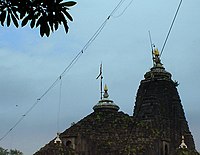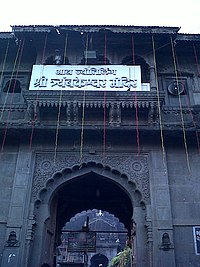Trimbakeshwar Shiva Temple
| Shri Trimbakeshwar Shiva Temple | |
|---|---|
Shri Trimbakeshwar Mandir | |
Hemadpanthi | |
| Creator | Balaji Baji Rao |
| Website | |
| Trimbakeshwar Trust Website | |
| Part of a series on |
| Shaivism |
|---|
 |
|
|
The Shri Trimbakeshwar Shiva Temple (श्री त्र्यंबकेश्वर ज्योतिर्लिंग मंदिर) is an ancient
Kusavarta kunda (sacred pond) in the temple premises, built by Shrimant Sardar Raosaheb Parnerkar who was the Fadnavis of Indore State, is the source of the Godavari River, the second longest river in India. A bust of Sardar Fadnavis and his wife can be seen on the edge of the kunda. The current temple was built by Peshwa Balaji Baji Rao after it was destroyed by Mughal ruler Aurangzeb.[4]
Architecture
The temple is located between three hills namely Brahmagiri, Nilagiri and Kalagiri. The temple has three
Jyotirlinga

As per the
Shiva showed himself as a Jyotirlinga on the night of the Aridra Nakshatra. It is believed that a person can see the Jyotirlingas as columns of fire piercing through the earth as he reaches a higher level of spiritual attainment. Each Jyotirlinga site takes the name of the presiding deity. Basically, the Jyotirlinga signifies the infinite nature of Shiva. At the highest level, Shiva is regarded as formless, limitless, transcendent and unchanging absolute Brahman and the primal Atman (soul, self) of the universe.
Genealogy registers
Hindu genealogy registers at Trimbakeshwar are the genealogy registers of pilgrims maintained here by pandits.[13][14][15]
Temple legend

Shri Trimbakeshwar is a religious center having one of the twelve Jyotirlingas. The extraordinary feature of the Jyotirlinga located here is its three faces embodying Brahma, Vishnu, and Shiva. Due to the excessive use of water, the linga has started to erode. It is said that this erosion symbolizes the eroding nature of human society. The Lingas are covered by a jeweled crown which is placed over the Gold Mask of Trideva (Brahma Vishnu Shiva). The crown is said to be from the age of Pandavas and consists of diamonds, emeralds, and many precious stones. The crown is displayed every Monday from 4-5 pm (Shiva).
All other Jyotirlingas have Shiva as the main deity. The entire black stone temple is known for its appealing architecture and sculpture and is at the foothills of a mountain called Brahmagiri. Three sources of the Godavari originate from the Brahmagiri mountain.
This section may need to be rewritten to comply with Wikipedia's quality standards. (May 2023) |

Brahma worshipped God Trivikram when he came to Satya Loka (on earth) with the same holy water of the Ganges, to get the river Ganges held up by Shiva on his head, to flow. There was a famine of 24 years and people were affected by the pangs of hunger. However, Varuna - the God of Rains, pleased with the sage Gautama arranged rains every day in sage Gautama's ashram (dwelling place) which was in
However, Ganges was not prepared to part with Shiva, which irritated him. He made TandavNrutya (dance) on the peak of Brahmagiri and dashed his jata there. Frightened by this action, Ganges appeared on Brahmagiri. Later on, Ganges appeared in the Trimbak Tirtha. Maharishi Gautama praised her but she appeared on the mountain at various places and disappeared in anger. Maharishi Gautama could not bathe in her waters. The Ganges then appeared in Gangadwar, Varaha-tirtha, Rama-Laxman tirtha, Ganga Sagar tirtha. Still, Maharishi Gautama could not bathe in her waters. Then, Maharishi Gautama surrounded the river with enchanted grass and put a vow to her. The flow stopped there and the tirtha thus came to be called Kushavarta. It is from this Kushavarta that the river Godavari flows up to the sea. The sin of killing a cow by Maharishi Gautama was wiped off here.
This place is famous for its many religious rituals (vidhis). Narayan Nagbali, Kalsarpa Shanti, Tripindi Vidhi are done here. Narayan Nagbali puja is performed at Trimbakeshwar only. This puja is performed in three days. This puja is performed on special dates. Some days are not suitable to perform this puja. This puja is performed for many reasons like to cure an illness, going through bad times, killing a Cobra (Nag), childless couples, financial crisis or you want to perform some religious puja to have everything.
Trimbakeshwar town has a large number of Brahmin households and is also a centre for Vedic Gurukuls (kind of boarding school). It also has ashrams and Muths devoted to Ashtanga Yoga, the Hindu art of living.
The existing temple was built out of basalt after it was commissioned by
The Shiva deity of the temple consisted of the world-famous Nassak Diamond. It was looted by the British in the Third Anglo-Maratha War and lies with one owner or the other ever since. The diamond presently lies with Edward J. Hand, a trucking firm executive from Greenwich, Connecticut, USA
The place is known for its scenic beauty in rainy/monsoon season and is surrounded by lush green hills untouched by pollution. Anjaneri mountain, the birthplace of Hanuman, is 7 km from Trimbakeshwar.
Shri Nilambika/Dattatreya/ Matamba Temple

This temple is on top of the Neel mountain. All goddesses ('Matamba', 'Renuka', 'Mananmba') came here to see 'Parashuram' when he was performing penance (tapas). After his penance, he requested all goddesses to stay there and the temple was formed for these goddesses.
Akhil Bhartiya Shree Swami Samarth Gurupeeth, Trimbakeshwar Temple of Shri Swami Samarth Maharaj. This temple is 1 km from Shiva Temple. This temple is a marvelous example of
Connectivity
Shri Trimbakeshwar Shiva Temple is 30 kilometers on road from
References
- ^ "Trimbakeshwar Temple | Nashik District, Government of Maharashtra | India". Retrieved 2023-03-30.
- ISSN 0971-751X. Retrieved 2023-03-30.
- ^ "Shri Trimbakeshwar Devasthan Trust, Trimbakeshwar, Nashik". www.trimbakeshwartrust.com. Retrieved 2023-01-07.
- ^ "Shri Trimbakeshwar Devasthan Trust, Trimbakeshwar, Nashik". www.trimbakeshwartrust.com. Retrieved 2023-01-07.
- ISBN 978-81-7907-053-6.
- ^ a b c R. 2003, pp. 92-95
- ^ Eck 1999, p. 107
- ^ See: Gwynne 2008, Section on Char Dham
- ^ a b Lochtefeld 2002, pp. 324-325
- ^ Harding 1998, pp. 158-158
- ^ Vivekananda Vol. 4
- ^ Chaturvedi 2006, pp. 58-72
- ^ Tracing your Asian roots Archived 2017-04-26 at the Wayback Machine www.overseasindian.in.
- ^ Hindu Pilgrimage Marriage Records www.movinghere.org.uk.
- ^ 10 Places Across The World That Help You Trace Your Ancestors, India Times, 29 Jan 2017.
- ^ "Nearest Railway Station To Trimbakeshwar". NearestRailwayStation.com. 12 September 2020.
Notes
- Chaturvedi, B. K. (2006), Shiva Purana (First ed.), New Delhi: Diamond Pocket Books (P) Ltd, ISBN 81-7182-721-7
- Eck, Diana L. (1999), Banaras, city of light (First ed.), New York: Columbia University Press, ISBN 0-231-11447-8
- Gwynne, Paul (2009), World Religions in Practice: A Comparative Introduction, Oxford: Blackwell Publication, ISBN 978-1-4051-6702-4.
- Harding, Elizabeth U. (1998). "God, the Father". Kali: The Black Goddess of Dakshineswar. Motilal Banarsidass. pp. 156–157. ISBN 978-81-208-1450-9.
- Lochtefeld, James G. (2002), The Illustrated Encyclopedia of Hinduism: A-M, Rosen Publishing Group, p. 122, ISBN 0-8239-3179-X
- R., Venugopalam (2003), Meditation: Any Time Any Where (First ed.), Delhi: B. Jain Publishers (P) Ltd., ISBN 81-8056-373-1
- Vivekananda, Swami. "The Paris Congress of the History of Religions". The Complete Works of Swami Vivekananda. Vol. 4.



